Analyzing Food Production: Planning, Resources, and Management Report
VerifiedAdded on 2022/11/24
|10
|3175
|356
Report
AI Summary
This report delves into the critical aspects of managing food production within the hospitality industry. It begins by emphasizing the importance of food production and preparation in achieving organizational success and brand loyalty, highlighting the need for efficient and competitive systems. The report explores key principles such as menu planning, supply chain management, food safety and storage, standard operational procedures (SOPs), and staff training. It then examines various methods for planning food production, including conventional, convenience, and centralized approaches. Furthermore, the report addresses the resources necessary for consistent, safe, and timely food production, emphasizing food safety measures and the importance of resource management. It also discusses the role of SOPs in meeting key performance indicators (KPIs) and the monitoring methods to address variances in safety. The report concludes by underscoring the impact of deviations from established procedures and the overall significance of effective food production management in the hospitality sector. This is a comprehensive report covering essential aspects of managing food production, including planning, resource management, and safety.
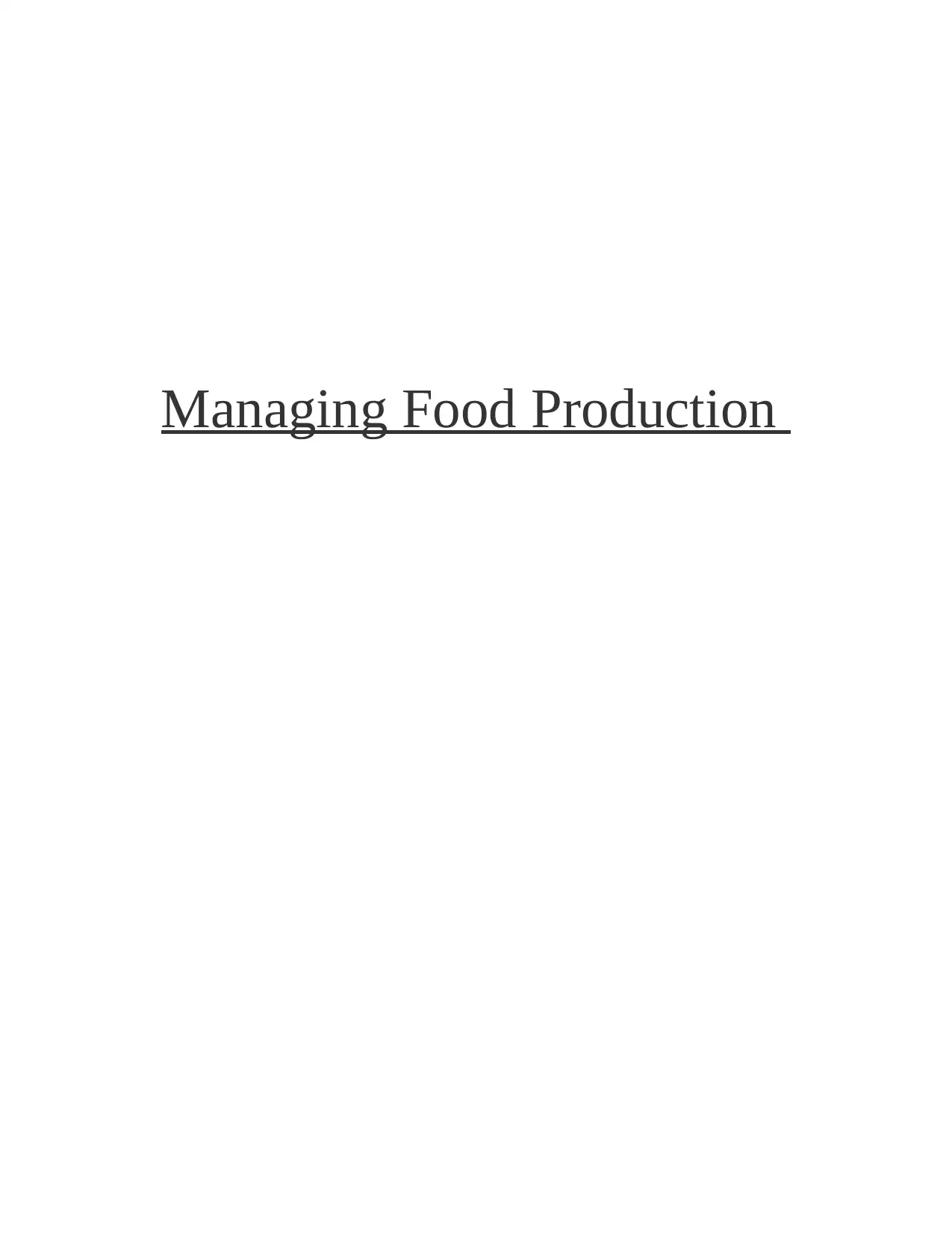
Managing Food Production
Paraphrase This Document
Need a fresh take? Get an instant paraphrase of this document with our AI Paraphraser
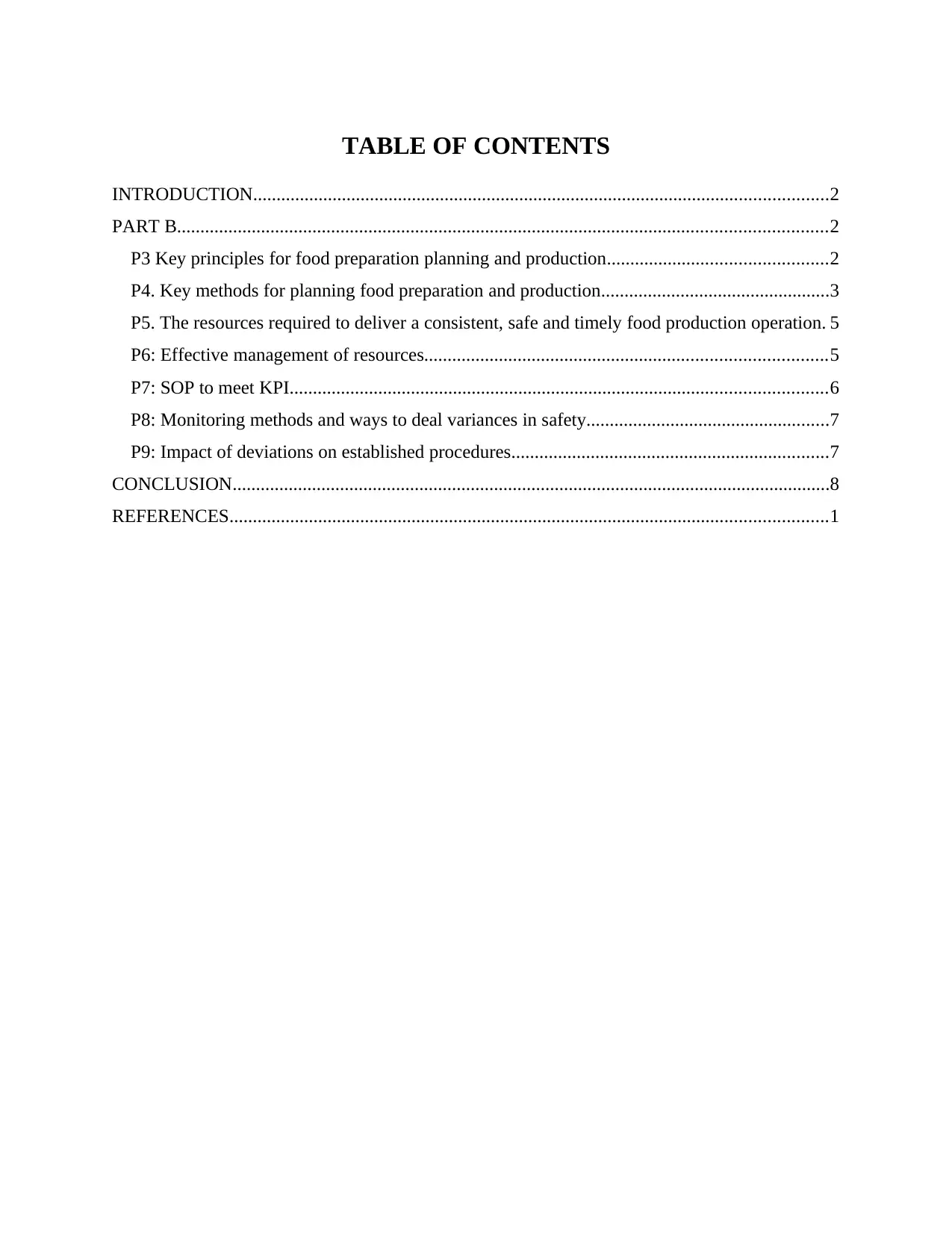
TABLE OF CONTENTS
INTRODUCTION...........................................................................................................................2
PART B...........................................................................................................................................2
P3 Key principles for food preparation planning and production...............................................2
P4. Key methods for planning food preparation and production.................................................3
P5. The resources required to deliver a consistent, safe and timely food production operation. 5
P6: Effective management of resources......................................................................................5
P7: SOP to meet KPI...................................................................................................................6
P8: Monitoring methods and ways to deal variances in safety....................................................7
P9: Impact of deviations on established procedures....................................................................7
CONCLUSION................................................................................................................................8
REFERENCES................................................................................................................................1
INTRODUCTION...........................................................................................................................2
PART B...........................................................................................................................................2
P3 Key principles for food preparation planning and production...............................................2
P4. Key methods for planning food preparation and production.................................................3
P5. The resources required to deliver a consistent, safe and timely food production operation. 5
P6: Effective management of resources......................................................................................5
P7: SOP to meet KPI...................................................................................................................6
P8: Monitoring methods and ways to deal variances in safety....................................................7
P9: Impact of deviations on established procedures....................................................................7
CONCLUSION................................................................................................................................8
REFERENCES................................................................................................................................1
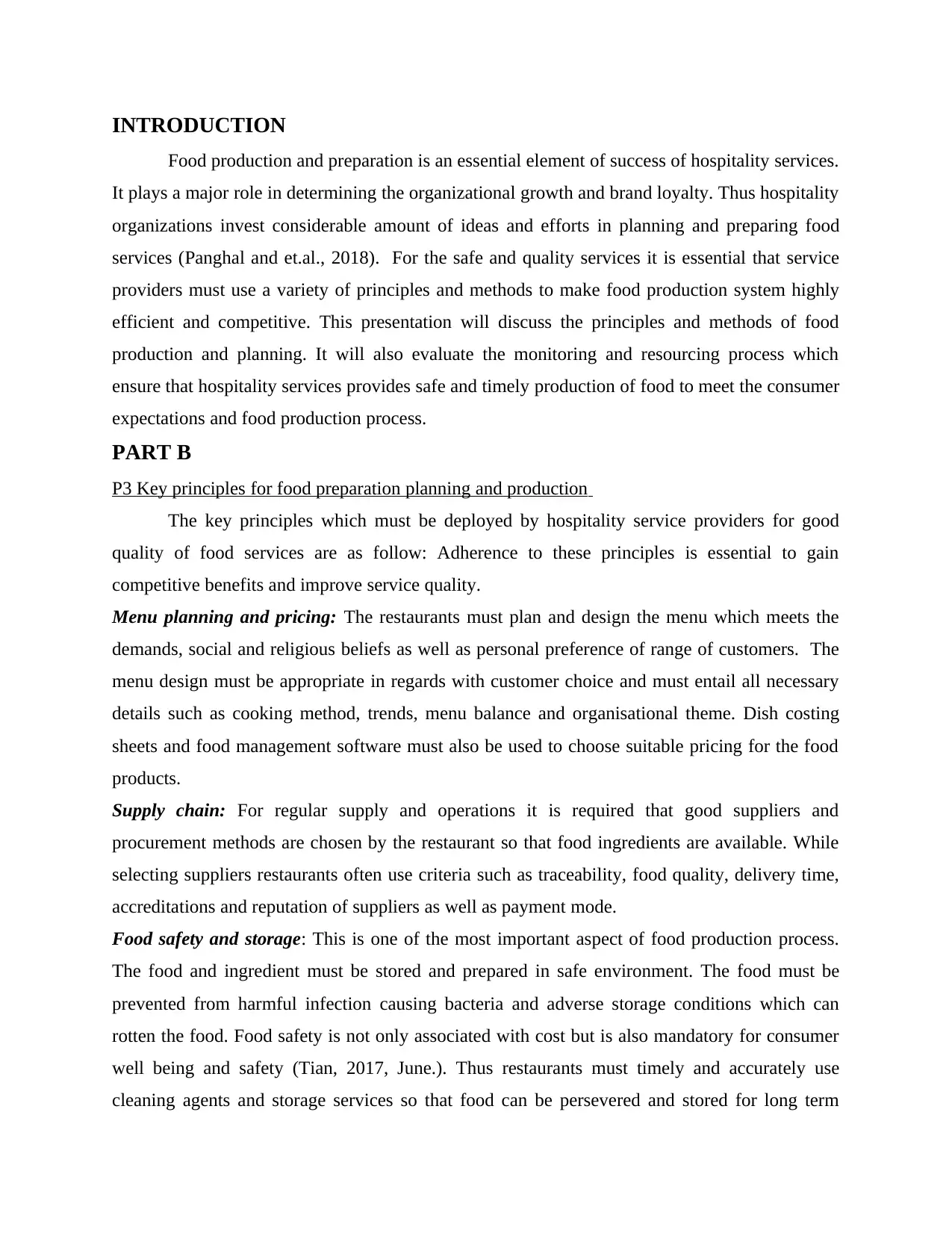
INTRODUCTION
Food production and preparation is an essential element of success of hospitality services.
It plays a major role in determining the organizational growth and brand loyalty. Thus hospitality
organizations invest considerable amount of ideas and efforts in planning and preparing food
services (Panghal and et.al., 2018). For the safe and quality services it is essential that service
providers must use a variety of principles and methods to make food production system highly
efficient and competitive. This presentation will discuss the principles and methods of food
production and planning. It will also evaluate the monitoring and resourcing process which
ensure that hospitality services provides safe and timely production of food to meet the consumer
expectations and food production process.
PART B
P3 Key principles for food preparation planning and production
The key principles which must be deployed by hospitality service providers for good
quality of food services are as follow: Adherence to these principles is essential to gain
competitive benefits and improve service quality.
Menu planning and pricing: The restaurants must plan and design the menu which meets the
demands, social and religious beliefs as well as personal preference of range of customers. The
menu design must be appropriate in regards with customer choice and must entail all necessary
details such as cooking method, trends, menu balance and organisational theme. Dish costing
sheets and food management software must also be used to choose suitable pricing for the food
products.
Supply chain: For regular supply and operations it is required that good suppliers and
procurement methods are chosen by the restaurant so that food ingredients are available. While
selecting suppliers restaurants often use criteria such as traceability, food quality, delivery time,
accreditations and reputation of suppliers as well as payment mode.
Food safety and storage: This is one of the most important aspect of food production process.
The food and ingredient must be stored and prepared in safe environment. The food must be
prevented from harmful infection causing bacteria and adverse storage conditions which can
rotten the food. Food safety is not only associated with cost but is also mandatory for consumer
well being and safety (Tian, 2017, June.). Thus restaurants must timely and accurately use
cleaning agents and storage services so that food can be persevered and stored for long term
Food production and preparation is an essential element of success of hospitality services.
It plays a major role in determining the organizational growth and brand loyalty. Thus hospitality
organizations invest considerable amount of ideas and efforts in planning and preparing food
services (Panghal and et.al., 2018). For the safe and quality services it is essential that service
providers must use a variety of principles and methods to make food production system highly
efficient and competitive. This presentation will discuss the principles and methods of food
production and planning. It will also evaluate the monitoring and resourcing process which
ensure that hospitality services provides safe and timely production of food to meet the consumer
expectations and food production process.
PART B
P3 Key principles for food preparation planning and production
The key principles which must be deployed by hospitality service providers for good
quality of food services are as follow: Adherence to these principles is essential to gain
competitive benefits and improve service quality.
Menu planning and pricing: The restaurants must plan and design the menu which meets the
demands, social and religious beliefs as well as personal preference of range of customers. The
menu design must be appropriate in regards with customer choice and must entail all necessary
details such as cooking method, trends, menu balance and organisational theme. Dish costing
sheets and food management software must also be used to choose suitable pricing for the food
products.
Supply chain: For regular supply and operations it is required that good suppliers and
procurement methods are chosen by the restaurant so that food ingredients are available. While
selecting suppliers restaurants often use criteria such as traceability, food quality, delivery time,
accreditations and reputation of suppliers as well as payment mode.
Food safety and storage: This is one of the most important aspect of food production process.
The food and ingredient must be stored and prepared in safe environment. The food must be
prevented from harmful infection causing bacteria and adverse storage conditions which can
rotten the food. Food safety is not only associated with cost but is also mandatory for consumer
well being and safety (Tian, 2017, June.). Thus restaurants must timely and accurately use
cleaning agents and storage services so that food can be persevered and stored for long term
⊘ This is a preview!⊘
Do you want full access?
Subscribe today to unlock all pages.

Trusted by 1+ million students worldwide
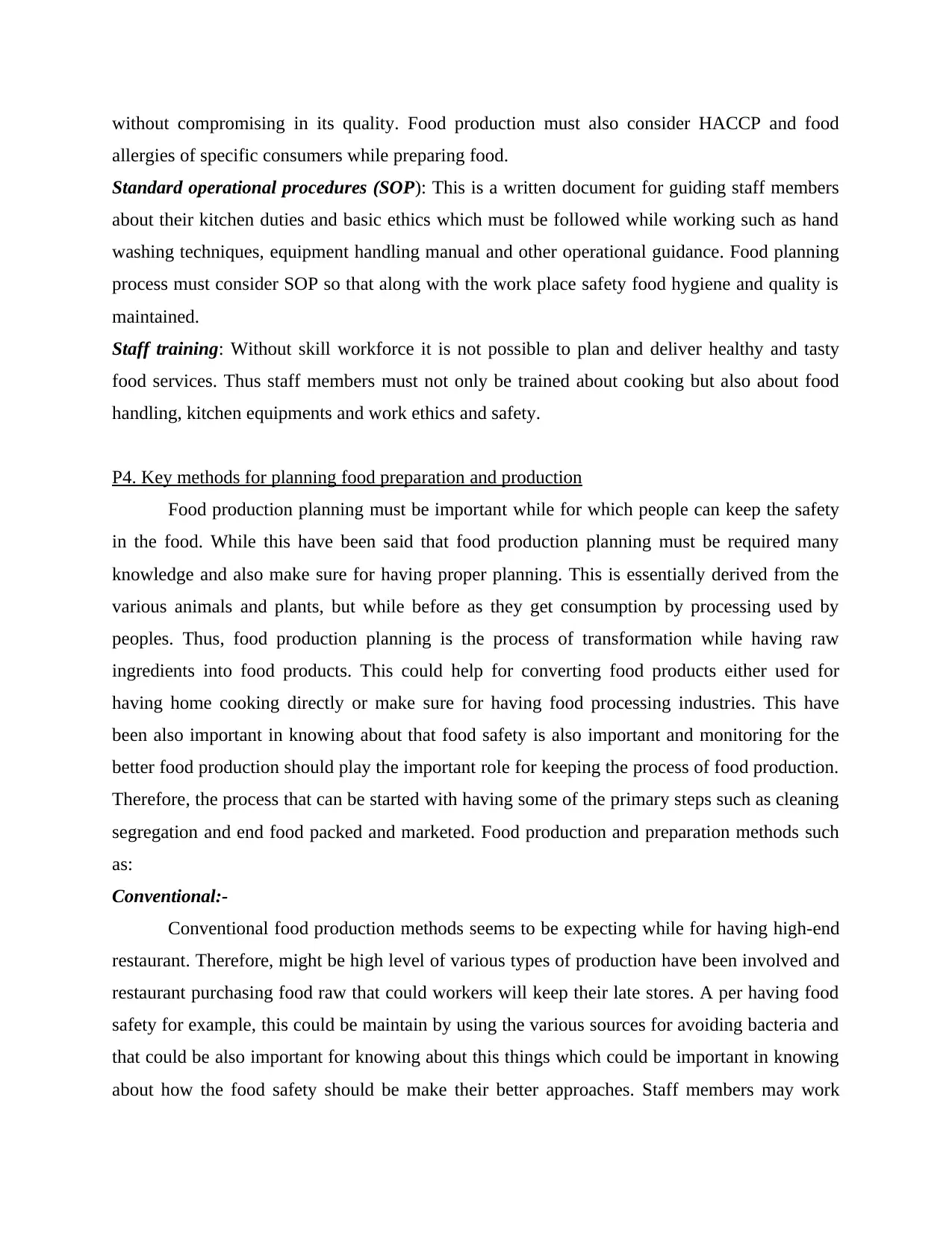
without compromising in its quality. Food production must also consider HACCP and food
allergies of specific consumers while preparing food.
Standard operational procedures (SOP): This is a written document for guiding staff members
about their kitchen duties and basic ethics which must be followed while working such as hand
washing techniques, equipment handling manual and other operational guidance. Food planning
process must consider SOP so that along with the work place safety food hygiene and quality is
maintained.
Staff training: Without skill workforce it is not possible to plan and deliver healthy and tasty
food services. Thus staff members must not only be trained about cooking but also about food
handling, kitchen equipments and work ethics and safety.
P4. Key methods for planning food preparation and production
Food production planning must be important while for which people can keep the safety
in the food. While this have been said that food production planning must be required many
knowledge and also make sure for having proper planning. This is essentially derived from the
various animals and plants, but while before as they get consumption by processing used by
peoples. Thus, food production planning is the process of transformation while having raw
ingredients into food products. This could help for converting food products either used for
having home cooking directly or make sure for having food processing industries. This have
been also important in knowing about that food safety is also important and monitoring for the
better food production should play the important role for keeping the process of food production.
Therefore, the process that can be started with having some of the primary steps such as cleaning
segregation and end food packed and marketed. Food production and preparation methods such
as:
Conventional:-
Conventional food production methods seems to be expecting while for having high-end
restaurant. Therefore, might be high level of various types of production have been involved and
restaurant purchasing food raw that could workers will keep their late stores. A per having food
safety for example, this could be maintain by using the various sources for avoiding bacteria and
that could be also important for knowing about this things which could be important in knowing
about how the food safety should be make their better approaches. Staff members may work
allergies of specific consumers while preparing food.
Standard operational procedures (SOP): This is a written document for guiding staff members
about their kitchen duties and basic ethics which must be followed while working such as hand
washing techniques, equipment handling manual and other operational guidance. Food planning
process must consider SOP so that along with the work place safety food hygiene and quality is
maintained.
Staff training: Without skill workforce it is not possible to plan and deliver healthy and tasty
food services. Thus staff members must not only be trained about cooking but also about food
handling, kitchen equipments and work ethics and safety.
P4. Key methods for planning food preparation and production
Food production planning must be important while for which people can keep the safety
in the food. While this have been said that food production planning must be required many
knowledge and also make sure for having proper planning. This is essentially derived from the
various animals and plants, but while before as they get consumption by processing used by
peoples. Thus, food production planning is the process of transformation while having raw
ingredients into food products. This could help for converting food products either used for
having home cooking directly or make sure for having food processing industries. This have
been also important in knowing about that food safety is also important and monitoring for the
better food production should play the important role for keeping the process of food production.
Therefore, the process that can be started with having some of the primary steps such as cleaning
segregation and end food packed and marketed. Food production and preparation methods such
as:
Conventional:-
Conventional food production methods seems to be expecting while for having high-end
restaurant. Therefore, might be high level of various types of production have been involved and
restaurant purchasing food raw that could workers will keep their late stores. A per having food
safety for example, this could be maintain by using the various sources for avoiding bacteria and
that could be also important for knowing about this things which could be important in knowing
about how the food safety should be make their better approaches. Staff members may work
Paraphrase This Document
Need a fresh take? Get an instant paraphrase of this document with our AI Paraphraser
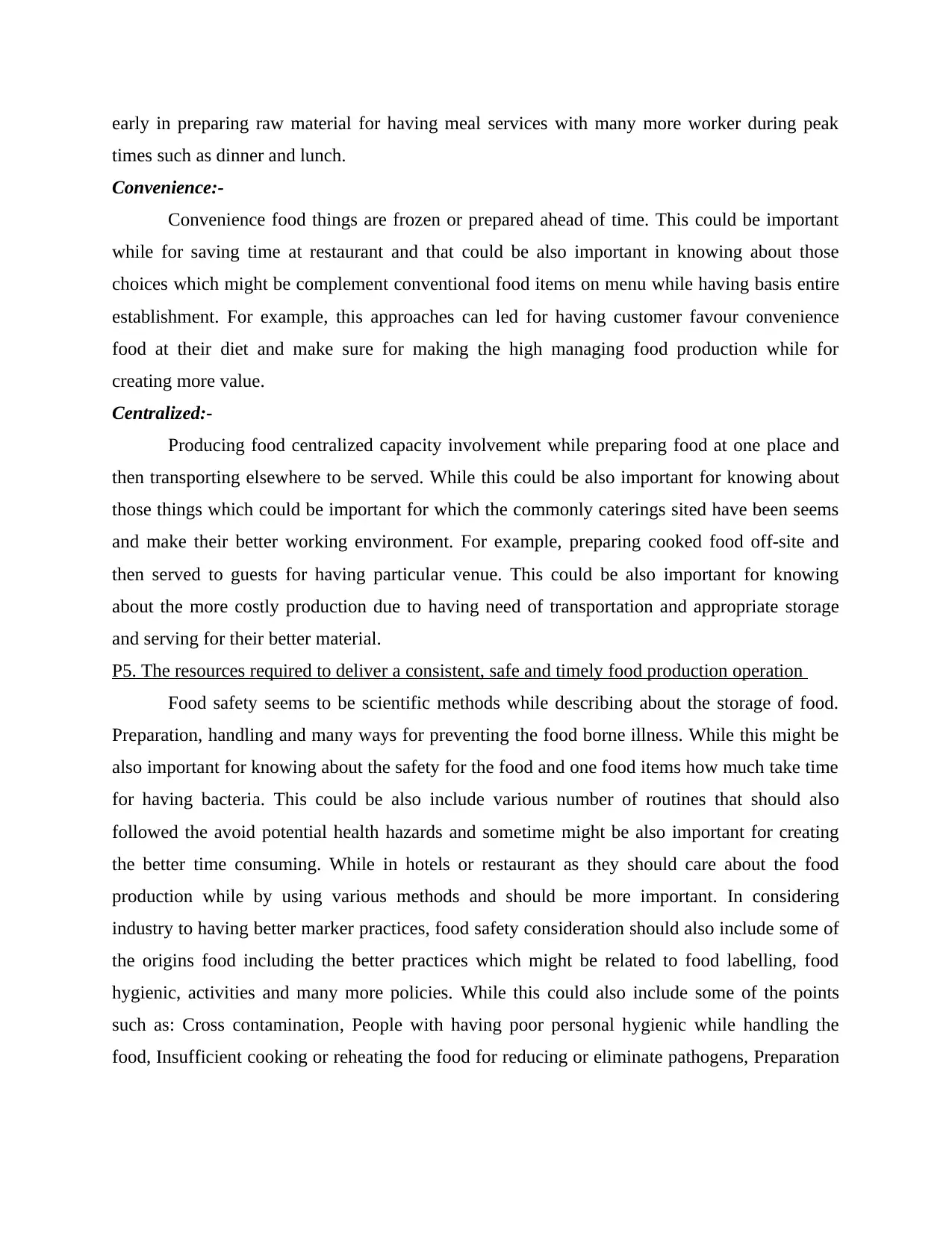
early in preparing raw material for having meal services with many more worker during peak
times such as dinner and lunch.
Convenience:-
Convenience food things are frozen or prepared ahead of time. This could be important
while for saving time at restaurant and that could be also important in knowing about those
choices which might be complement conventional food items on menu while having basis entire
establishment. For example, this approaches can led for having customer favour convenience
food at their diet and make sure for making the high managing food production while for
creating more value.
Centralized:-
Producing food centralized capacity involvement while preparing food at one place and
then transporting elsewhere to be served. While this could be also important for knowing about
those things which could be important for which the commonly caterings sited have been seems
and make their better working environment. For example, preparing cooked food off-site and
then served to guests for having particular venue. This could be also important for knowing
about the more costly production due to having need of transportation and appropriate storage
and serving for their better material.
P5. The resources required to deliver a consistent, safe and timely food production operation
Food safety seems to be scientific methods while describing about the storage of food.
Preparation, handling and many ways for preventing the food borne illness. While this might be
also important for knowing about the safety for the food and one food items how much take time
for having bacteria. This could be also include various number of routines that should also
followed the avoid potential health hazards and sometime might be also important for creating
the better time consuming. While in hotels or restaurant as they should care about the food
production while by using various methods and should be more important. In considering
industry to having better marker practices, food safety consideration should also include some of
the origins food including the better practices which might be related to food labelling, food
hygienic, activities and many more policies. While this could also include some of the points
such as: Cross contamination, People with having poor personal hygienic while handling the
food, Insufficient cooking or reheating the food for reducing or eliminate pathogens, Preparation
times such as dinner and lunch.
Convenience:-
Convenience food things are frozen or prepared ahead of time. This could be important
while for saving time at restaurant and that could be also important in knowing about those
choices which might be complement conventional food items on menu while having basis entire
establishment. For example, this approaches can led for having customer favour convenience
food at their diet and make sure for making the high managing food production while for
creating more value.
Centralized:-
Producing food centralized capacity involvement while preparing food at one place and
then transporting elsewhere to be served. While this could be also important for knowing about
those things which could be important for which the commonly caterings sited have been seems
and make their better working environment. For example, preparing cooked food off-site and
then served to guests for having particular venue. This could be also important for knowing
about the more costly production due to having need of transportation and appropriate storage
and serving for their better material.
P5. The resources required to deliver a consistent, safe and timely food production operation
Food safety seems to be scientific methods while describing about the storage of food.
Preparation, handling and many ways for preventing the food borne illness. While this might be
also important for knowing about the safety for the food and one food items how much take time
for having bacteria. This could be also include various number of routines that should also
followed the avoid potential health hazards and sometime might be also important for creating
the better time consuming. While in hotels or restaurant as they should care about the food
production while by using various methods and should be more important. In considering
industry to having better marker practices, food safety consideration should also include some of
the origins food including the better practices which might be related to food labelling, food
hygienic, activities and many more policies. While this could also include some of the points
such as: Cross contamination, People with having poor personal hygienic while handling the
food, Insufficient cooking or reheating the food for reducing or eliminate pathogens, Preparation

of food should be done while several hours before the consumption, along with the combination
of the storage in temperature which favour for growth of bacteria/formation for toxins.
Food can be also transmit pathogens which can be have result for illness and the people
should also make sure for having the time conversation for the food. There might be main types
of pathogens such as bacteria, fungus, viruses etc. While this have been also seems that in
developing countries intricate standards steps are being taken for the food preparation. Whereas,
in less developed countries there might be fewer standards and have less enforcement of those
standards. While this might be also known for having production operation while before having
the food planning. This could be also important for taking advantage for working with proper
process of the standards in well-developed countries. WHO have also indicates about that only
small numbers of treated food production are handling and working towards the large proportion
of food borne diseases episodes and have the better food planning for the various other people.
P6: Effective management of resources
For safe and efficient food production each member of kitchen must have clear roles and
responsibility. They must be given appropriate training and information about the standard
procedures to meet the client requirement. Along with the skilled and trained human resources
restaurants must also ensure that they have all necessary finance and physical resources. The
kitchen must be equipped with necessary tools and equipments so that services can be delivered
unhindered. There must be regular schedules as well for monitoring and repairing work so that
services can be provided without any disruption (Stevens and Hood, 2019). For safe and quality
food production it is also required that food safety systems are in compliance with the standard
legislations and all physical resources must be maintained so that they are safe for the use. The
use of financial resources is also one of the most critical aspect and thus budget must be planned
and control. The staff members must take steps to minimise the waste and to manage inventory
with proper planning so that financial resources are deployed with proper planning. Financial
resources must be managed with fix standards and procedures so that brand standards can also be
adhered with particular kitchen resources.
P7: SOP to meet KPI
Key performance indicators such as customer review return of investment and occupancy
rates are greatly influenced by the quality of services provided. Thus it is crucial that there must
be standard operational procedure so that errors and quality compromises can be avoided. To
of the storage in temperature which favour for growth of bacteria/formation for toxins.
Food can be also transmit pathogens which can be have result for illness and the people
should also make sure for having the time conversation for the food. There might be main types
of pathogens such as bacteria, fungus, viruses etc. While this have been also seems that in
developing countries intricate standards steps are being taken for the food preparation. Whereas,
in less developed countries there might be fewer standards and have less enforcement of those
standards. While this might be also known for having production operation while before having
the food planning. This could be also important for taking advantage for working with proper
process of the standards in well-developed countries. WHO have also indicates about that only
small numbers of treated food production are handling and working towards the large proportion
of food borne diseases episodes and have the better food planning for the various other people.
P6: Effective management of resources
For safe and efficient food production each member of kitchen must have clear roles and
responsibility. They must be given appropriate training and information about the standard
procedures to meet the client requirement. Along with the skilled and trained human resources
restaurants must also ensure that they have all necessary finance and physical resources. The
kitchen must be equipped with necessary tools and equipments so that services can be delivered
unhindered. There must be regular schedules as well for monitoring and repairing work so that
services can be provided without any disruption (Stevens and Hood, 2019). For safe and quality
food production it is also required that food safety systems are in compliance with the standard
legislations and all physical resources must be maintained so that they are safe for the use. The
use of financial resources is also one of the most critical aspect and thus budget must be planned
and control. The staff members must take steps to minimise the waste and to manage inventory
with proper planning so that financial resources are deployed with proper planning. Financial
resources must be managed with fix standards and procedures so that brand standards can also be
adhered with particular kitchen resources.
P7: SOP to meet KPI
Key performance indicators such as customer review return of investment and occupancy
rates are greatly influenced by the quality of services provided. Thus it is crucial that there must
be standard operational procedure so that errors and quality compromises can be avoided. To
⊘ This is a preview!⊘
Do you want full access?
Subscribe today to unlock all pages.

Trusted by 1+ million students worldwide

improve the customer satisfaction and to reduce the operational cost standard procedure must be
implemented and trained to employees. It will help to follow the most efficient way of
performing operations and to minimise the resource wastage. Once standards are implemented
they must be measured by keeping proper records or by cross checking with the regulatory
standards (Liggans and et.al., 2019). The monitoring of SOP will not only encourage employees
to follow them but will also assist in identifying the scope and need of adjustments in
procedures. Before implementing any standards procedure it must be implemented for trial and
its limitations must also be listed so that they can deliver the required return. If there is no SOP
then it can cause miscommunication among team members and service quality may get affected
seriously. Also this can cause serious implications in terms of poor food quality and safety of the
food. It has been also observed that if there are not fixed procedures then it can have adverse
impact on brand value. As due to lack of procedures employees may not consider food safety as
priority and it may get compromise depending upon the ability and skill of an individual. Thus
organisation may never get success in establishing itself as quality service provider.
P8: Monitoring methods and ways to deal variances in safety
Food safety is one of the most critical aspects of food production and restaurant services
which need regular and strict monitoring. There must be regular inspection of food quality so
that its safety and hygiene can be ensured. For regulating food safety along with the physical
inspection and controlling various food safety tests can also be performed using the approaches
to measure the taste, odour, appearance and nutrition level of the food. If this aspect is not
monitored then it can cause harm to safety of the customers and they can face serious health
complications. In addition to this it will also result in the damage to organisational value.
In addition to food quality stock level and waste quantity must also be monitored. The
regular records of inventory must be updated and monitored so that there are sufficient resources
in the kitchen (Chen and et.al., 2020). Further it will also prevent over stocking and degradation
in the quality of inventory due to stocking for prolong period. This monitoring can be done by
maintaining proper records and keeping regular updates in them. The team members can also
coordinate with each other for this purpose. If there are variance in food quality then such food
items must immediately dumped so that it does not cause harm. Also the waste produced from
the kitchen must be minimised and monitored to ensure that resources are utilised in proper
manner without compromising the quality and safety of food. It is also required to lower the
implemented and trained to employees. It will help to follow the most efficient way of
performing operations and to minimise the resource wastage. Once standards are implemented
they must be measured by keeping proper records or by cross checking with the regulatory
standards (Liggans and et.al., 2019). The monitoring of SOP will not only encourage employees
to follow them but will also assist in identifying the scope and need of adjustments in
procedures. Before implementing any standards procedure it must be implemented for trial and
its limitations must also be listed so that they can deliver the required return. If there is no SOP
then it can cause miscommunication among team members and service quality may get affected
seriously. Also this can cause serious implications in terms of poor food quality and safety of the
food. It has been also observed that if there are not fixed procedures then it can have adverse
impact on brand value. As due to lack of procedures employees may not consider food safety as
priority and it may get compromise depending upon the ability and skill of an individual. Thus
organisation may never get success in establishing itself as quality service provider.
P8: Monitoring methods and ways to deal variances in safety
Food safety is one of the most critical aspects of food production and restaurant services
which need regular and strict monitoring. There must be regular inspection of food quality so
that its safety and hygiene can be ensured. For regulating food safety along with the physical
inspection and controlling various food safety tests can also be performed using the approaches
to measure the taste, odour, appearance and nutrition level of the food. If this aspect is not
monitored then it can cause harm to safety of the customers and they can face serious health
complications. In addition to this it will also result in the damage to organisational value.
In addition to food quality stock level and waste quantity must also be monitored. The
regular records of inventory must be updated and monitored so that there are sufficient resources
in the kitchen (Chen and et.al., 2020). Further it will also prevent over stocking and degradation
in the quality of inventory due to stocking for prolong period. This monitoring can be done by
maintaining proper records and keeping regular updates in them. The team members can also
coordinate with each other for this purpose. If there are variance in food quality then such food
items must immediately dumped so that it does not cause harm. Also the waste produced from
the kitchen must be minimised and monitored to ensure that resources are utilised in proper
manner without compromising the quality and safety of food. It is also required to lower the
Paraphrase This Document
Need a fresh take? Get an instant paraphrase of this document with our AI Paraphraser
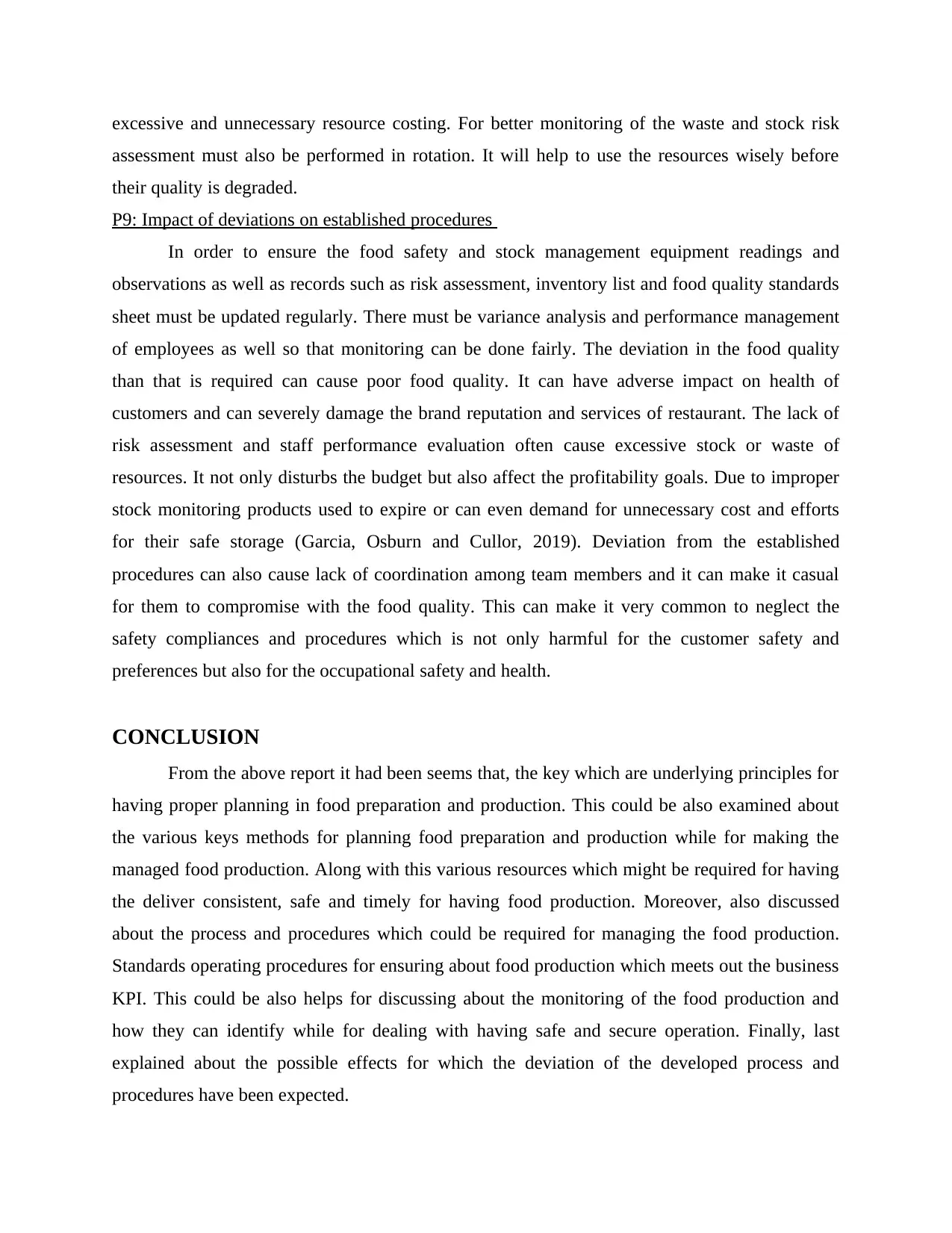
excessive and unnecessary resource costing. For better monitoring of the waste and stock risk
assessment must also be performed in rotation. It will help to use the resources wisely before
their quality is degraded.
P9: Impact of deviations on established procedures
In order to ensure the food safety and stock management equipment readings and
observations as well as records such as risk assessment, inventory list and food quality standards
sheet must be updated regularly. There must be variance analysis and performance management
of employees as well so that monitoring can be done fairly. The deviation in the food quality
than that is required can cause poor food quality. It can have adverse impact on health of
customers and can severely damage the brand reputation and services of restaurant. The lack of
risk assessment and staff performance evaluation often cause excessive stock or waste of
resources. It not only disturbs the budget but also affect the profitability goals. Due to improper
stock monitoring products used to expire or can even demand for unnecessary cost and efforts
for their safe storage (Garcia, Osburn and Cullor, 2019). Deviation from the established
procedures can also cause lack of coordination among team members and it can make it casual
for them to compromise with the food quality. This can make it very common to neglect the
safety compliances and procedures which is not only harmful for the customer safety and
preferences but also for the occupational safety and health.
CONCLUSION
From the above report it had been seems that, the key which are underlying principles for
having proper planning in food preparation and production. This could be also examined about
the various keys methods for planning food preparation and production while for making the
managed food production. Along with this various resources which might be required for having
the deliver consistent, safe and timely for having food production. Moreover, also discussed
about the process and procedures which could be required for managing the food production.
Standards operating procedures for ensuring about food production which meets out the business
KPI. This could be also helps for discussing about the monitoring of the food production and
how they can identify while for dealing with having safe and secure operation. Finally, last
explained about the possible effects for which the deviation of the developed process and
procedures have been expected.
assessment must also be performed in rotation. It will help to use the resources wisely before
their quality is degraded.
P9: Impact of deviations on established procedures
In order to ensure the food safety and stock management equipment readings and
observations as well as records such as risk assessment, inventory list and food quality standards
sheet must be updated regularly. There must be variance analysis and performance management
of employees as well so that monitoring can be done fairly. The deviation in the food quality
than that is required can cause poor food quality. It can have adverse impact on health of
customers and can severely damage the brand reputation and services of restaurant. The lack of
risk assessment and staff performance evaluation often cause excessive stock or waste of
resources. It not only disturbs the budget but also affect the profitability goals. Due to improper
stock monitoring products used to expire or can even demand for unnecessary cost and efforts
for their safe storage (Garcia, Osburn and Cullor, 2019). Deviation from the established
procedures can also cause lack of coordination among team members and it can make it casual
for them to compromise with the food quality. This can make it very common to neglect the
safety compliances and procedures which is not only harmful for the customer safety and
preferences but also for the occupational safety and health.
CONCLUSION
From the above report it had been seems that, the key which are underlying principles for
having proper planning in food preparation and production. This could be also examined about
the various keys methods for planning food preparation and production while for making the
managed food production. Along with this various resources which might be required for having
the deliver consistent, safe and timely for having food production. Moreover, also discussed
about the process and procedures which could be required for managing the food production.
Standards operating procedures for ensuring about food production which meets out the business
KPI. This could be also helps for discussing about the monitoring of the food production and
how they can identify while for dealing with having safe and secure operation. Finally, last
explained about the possible effects for which the deviation of the developed process and
procedures have been expected.
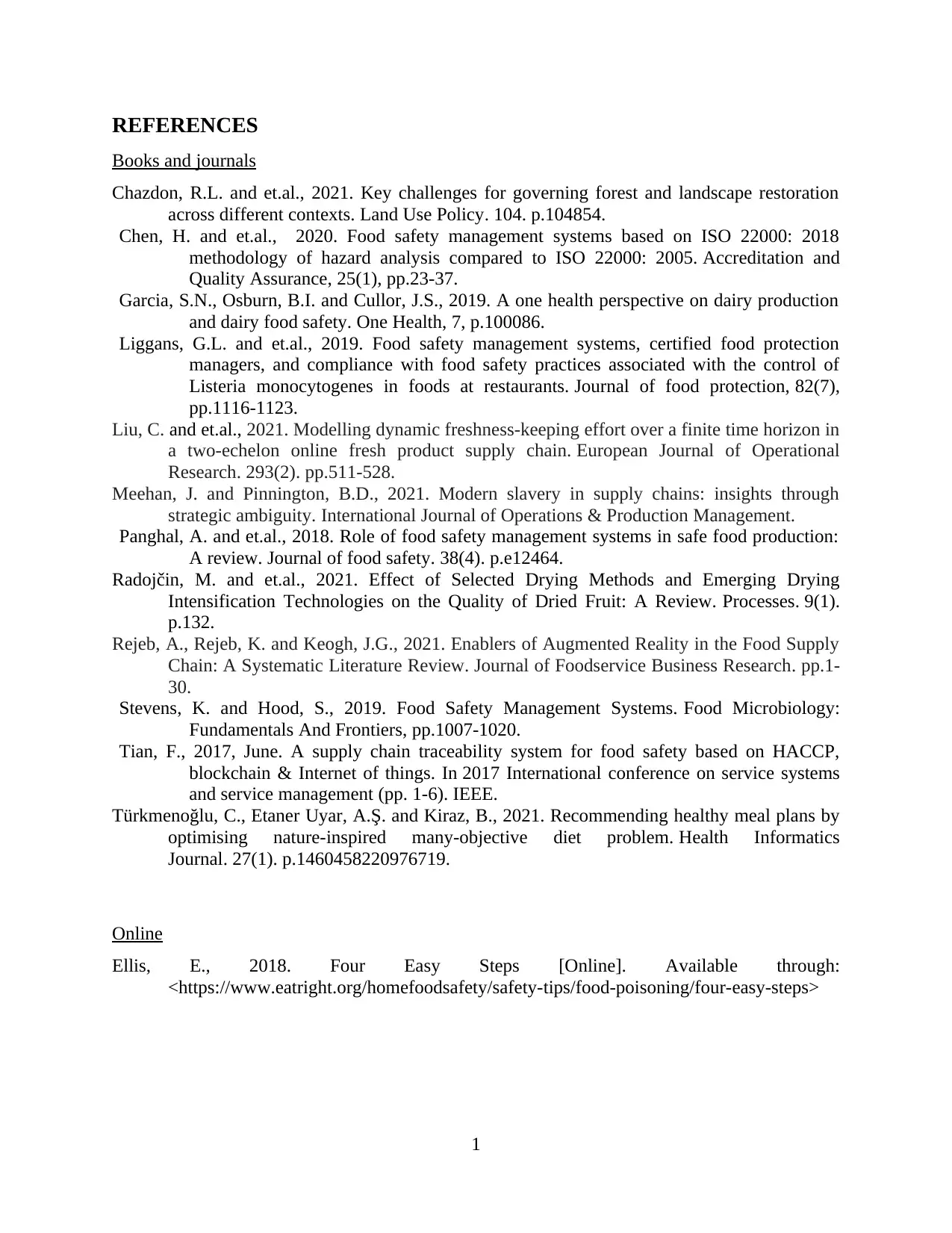
REFERENCES
Books and journals
Chazdon, R.L. and et.al., 2021. Key challenges for governing forest and landscape restoration
across different contexts. Land Use Policy. 104. p.104854.
Chen, H. and et.al., 2020. Food safety management systems based on ISO 22000: 2018
methodology of hazard analysis compared to ISO 22000: 2005. Accreditation and
Quality Assurance, 25(1), pp.23-37.
Garcia, S.N., Osburn, B.I. and Cullor, J.S., 2019. A one health perspective on dairy production
and dairy food safety. One Health, 7, p.100086.
Liggans, G.L. and et.al., 2019. Food safety management systems, certified food protection
managers, and compliance with food safety practices associated with the control of
Listeria monocytogenes in foods at restaurants. Journal of food protection, 82(7),
pp.1116-1123.
Liu, C. and et.al., 2021. Modelling dynamic freshness-keeping effort over a finite time horizon in
a two-echelon online fresh product supply chain. European Journal of Operational
Research. 293(2). pp.511-528.
Meehan, J. and Pinnington, B.D., 2021. Modern slavery in supply chains: insights through
strategic ambiguity. International Journal of Operations & Production Management.
Panghal, A. and et.al., 2018. Role of food safety management systems in safe food production:
A review. Journal of food safety. 38(4). p.e12464.
Radojčin, M. and et.al., 2021. Effect of Selected Drying Methods and Emerging Drying
Intensification Technologies on the Quality of Dried Fruit: A Review. Processes. 9(1).
p.132.
Rejeb, A., Rejeb, K. and Keogh, J.G., 2021. Enablers of Augmented Reality in the Food Supply
Chain: A Systematic Literature Review. Journal of Foodservice Business Research. pp.1-
30.
Stevens, K. and Hood, S., 2019. Food Safety Management Systems. Food Microbiology:
Fundamentals And Frontiers, pp.1007-1020.
Tian, F., 2017, June. A supply chain traceability system for food safety based on HACCP,
blockchain & Internet of things. In 2017 International conference on service systems
and service management (pp. 1-6). IEEE.
Türkmenoğlu, C., Etaner Uyar, A.Ş. and Kiraz, B., 2021. Recommending healthy meal plans by
optimising nature-inspired many-objective diet problem. Health Informatics
Journal. 27(1). p.1460458220976719.
Online
Ellis, E., 2018. Four Easy Steps [Online]. Available through:
<https://www.eatright.org/homefoodsafety/safety-tips/food-poisoning/four-easy-steps>
1
Books and journals
Chazdon, R.L. and et.al., 2021. Key challenges for governing forest and landscape restoration
across different contexts. Land Use Policy. 104. p.104854.
Chen, H. and et.al., 2020. Food safety management systems based on ISO 22000: 2018
methodology of hazard analysis compared to ISO 22000: 2005. Accreditation and
Quality Assurance, 25(1), pp.23-37.
Garcia, S.N., Osburn, B.I. and Cullor, J.S., 2019. A one health perspective on dairy production
and dairy food safety. One Health, 7, p.100086.
Liggans, G.L. and et.al., 2019. Food safety management systems, certified food protection
managers, and compliance with food safety practices associated with the control of
Listeria monocytogenes in foods at restaurants. Journal of food protection, 82(7),
pp.1116-1123.
Liu, C. and et.al., 2021. Modelling dynamic freshness-keeping effort over a finite time horizon in
a two-echelon online fresh product supply chain. European Journal of Operational
Research. 293(2). pp.511-528.
Meehan, J. and Pinnington, B.D., 2021. Modern slavery in supply chains: insights through
strategic ambiguity. International Journal of Operations & Production Management.
Panghal, A. and et.al., 2018. Role of food safety management systems in safe food production:
A review. Journal of food safety. 38(4). p.e12464.
Radojčin, M. and et.al., 2021. Effect of Selected Drying Methods and Emerging Drying
Intensification Technologies on the Quality of Dried Fruit: A Review. Processes. 9(1).
p.132.
Rejeb, A., Rejeb, K. and Keogh, J.G., 2021. Enablers of Augmented Reality in the Food Supply
Chain: A Systematic Literature Review. Journal of Foodservice Business Research. pp.1-
30.
Stevens, K. and Hood, S., 2019. Food Safety Management Systems. Food Microbiology:
Fundamentals And Frontiers, pp.1007-1020.
Tian, F., 2017, June. A supply chain traceability system for food safety based on HACCP,
blockchain & Internet of things. In 2017 International conference on service systems
and service management (pp. 1-6). IEEE.
Türkmenoğlu, C., Etaner Uyar, A.Ş. and Kiraz, B., 2021. Recommending healthy meal plans by
optimising nature-inspired many-objective diet problem. Health Informatics
Journal. 27(1). p.1460458220976719.
Online
Ellis, E., 2018. Four Easy Steps [Online]. Available through:
<https://www.eatright.org/homefoodsafety/safety-tips/food-poisoning/four-easy-steps>
1
⊘ This is a preview!⊘
Do you want full access?
Subscribe today to unlock all pages.

Trusted by 1+ million students worldwide

2
1 out of 10
Related Documents
Your All-in-One AI-Powered Toolkit for Academic Success.
+13062052269
info@desklib.com
Available 24*7 on WhatsApp / Email
![[object Object]](/_next/static/media/star-bottom.7253800d.svg)
Unlock your academic potential
Copyright © 2020–2025 A2Z Services. All Rights Reserved. Developed and managed by ZUCOL.





